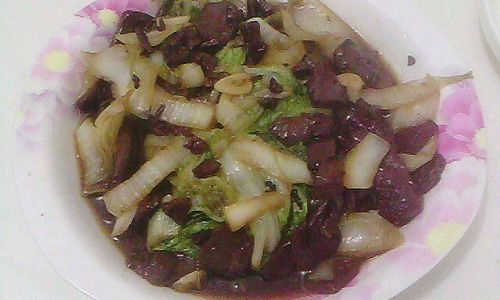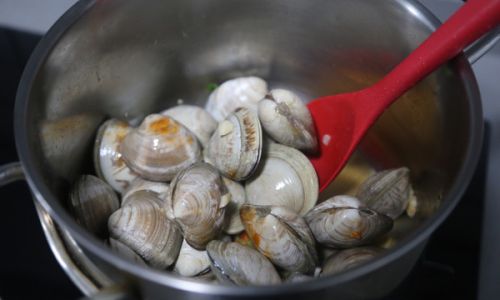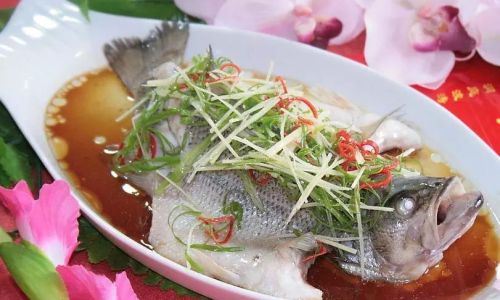Table of content
Stir-fried pig’s blood with Chinese cabbage, often referred to as “bai cai chao xue dou” in Chinese cuisine, is a dish that balances earthy flavors with crisp textures. This humble yet nutritious meal is a staple in many households, particularly in regions where pig’s blood is a common ingredient. While it may sound unconventional to those unfamiliar with it, pig’s blood is a rich source of iron and protein, and when cooked properly, it absorbs the flavors of aromatics like garlic and ginger, creating a deeply satisfying dish. Paired with tender Chinese cabbage, this recipe offers a harmonious blend of umami and freshness. Below is a detailed guide to mastering this dish, from selecting the finest ingredients to achieving the perfect balance of seasonings.
Ingredients
To serve 4-6 people, gather the following:

- 400 grams fresh pig’s blood (often sold pre-cooked and solidified in blocks; if unavailable, substitute with blood tofu, a processed version found in Asian markets)
- 1 medium Chinese cabbage (about 600 grams), washed and sliced into 2-inch strips
- 3 garlic cloves, minced
- 1-inch ginger, peeled and grated
- 2-3 dried red chilies (optional, for heat)
- 3 tablespoons cooking oil (peanut, vegetable, or sesame oil work best)
- 2 tablespoons light soy sauce
- 1 tablespoon dark soy sauce (for color)
- 1 teaspoon sugar
- 1 teaspoon white pepper
- 1/2 teaspoon salt (adjust to taste)
- 1/4 cup water or chicken broth
- 2 green onions, chopped (for garnish)
- 1 teaspoon sesame oil (optional, for finishing)
Preparation Steps
Preparing the Pig’s Blood
If using fresh pig’s blood, it is typically sold in a coagulated form. Rinse it under cold water to remove any impurities, then cut it into 1-inch cubes. If using pre-packaged blood tofu, drain any excess liquid and pat it dry with paper towels to prevent splattering during cooking.
Pro Tip: Some recipes call for blanching the pig’s blood cubes in boiling water for 1-2 minutes before stir-frying. This step helps firm up the texture and remove any residual impurities. Drain and set aside.
Prepping the Chinese Cabbage
Chinese cabbage, also known as napa cabbage, has a mild, sweet flavor and crisp leaves. Remove any wilted outer leaves, then slice the cabbage lengthwise into quarters. Chop each quarter into 2-inch strips, separating the tender white stems from the leafy green parts. The stems take slightly longer to cook, so adding them to the pan first ensures even cooking.
Aromatics and Seasonings
Mince the garlic and grate the ginger finely. These aromatics form the flavor base of the dish. If using dried chilies, snip them into small pieces (discard the seeds for less heat).
Cooking Instructions
Searing the Pig’s Blood
Heat 2 tablespoons of cooking oil in a wok or large skillet over medium-high heat. Once the oil shimmers, add the pig’s blood cubes in a single layer. Let them sear undisturbed for 2-3 minutes until golden brown on the bottom. Flip gently with a spatula and cook for another 2 minutes. This step caramelizes the surface, adding depth to the dish. Remove the blood cubes from the pan and set aside.
Stir-Frying the Aromatics
Add the remaining 1 tablespoon of oil to the pan. Toss in the minced garlic, grated ginger, and dried chilies (if using). Stir-fry for 30 seconds until fragrant, taking care not to burn the garlic.
Cooking the Cabbage
Add the white stems of the cabbage to the pan first, as they require slightly longer cooking. Stir-fry for 2-3 minutes until they begin to soften. Next, add the leafy green parts and toss gently. Pour in the water or chicken broth to create steam, which helps wilt the cabbage without overcooking it. Cover the pan and let it cook for 3-4 minutes until the cabbage is tender but still vibrant green.
Combining Ingredients
Return the seared pig’s blood cubes to the pan. Drizzle the light soy sauce, dark soy sauce, and sugar over the mixture. Sprinkle with white pepper and salt. Gently toss everything together to coat the ingredients evenly. Avoid overstirring, as this may break the pig’s blood cubes.

Finishing Touches
Drizzle with sesame oil (if using) for a nutty aroma. Taste and adjust seasoning with extra soy sauce or salt if needed. Transfer the dish to a serving platter and garnish with chopped green onions.
Serving Suggestions
Stir-fried pig’s blood with Chinese cabbage pairs beautifully with steamed rice or congee. Its rich flavors also complement mild-tasting grains like quinoa or barley. For a heartier meal, serve it alongside pan-fried dumplings or a simple tofu stir-fry.
Tips for Success
- Texture Control: Pig’s blood can become rubbery if overcooked. Sear it briefly to develop flavor, then add it back toward the end of cooking to retain its tender texture.
- Cabbage Variations: If Chinese cabbage is unavailable, substitute with bok choy or regular green cabbage. Adjust cooking time accordingly, as denser cabbages may require longer steaming.
- Spice Level: Customize the heat by adding more dried chilies, fresh chili paste, or a splash of chili oil.
- Protein Boost: For added substance, include sliced pork belly or mushrooms during the aromatics step.
- Vegetarian Adaptation: Use tofu or textured vegetable protein (TVP) as a substitute for pig’s blood, and replace chicken broth with vegetable broth.
Nutritional Benefits
Pig’s blood is a traditional ingredient in many Asian cuisines, valued for its high iron content, which aids in preventing anemia. Chinese cabbage contributes fiber, vitamins C and K, and antioxidants. Together, they form a dish that is both nourishing and low in calories, making it ideal for balanced diets.
Cultural Context
In Chinese culture, offal and blood-based dishes are celebrated for their frugality and nutritional value. Pig’s blood, in particular, is a symbol of sustainability, as it utilizes every part of the animal. This dish is often prepared during festivals or family gatherings, symbolizing prosperity and the importance of not wasting food.
Troubleshooting
- Mushy Cabbage: Overcooking releases excess moisture, making the cabbage soggy. Cook until just tender and avoid covering the pan for too long.
- Bland Flavor: Ensure the pig’s blood is well-seasoned with soy sauce and aromatics. Marinating the blood cubes briefly in soy sauce before searing can enhance flavor.
- Breaking Blood Cubes: Handle the cubes gently during stir-frying. Using a wide spatula and minimal stirring helps maintain their shape.
Conclusion
Mastering stir-fried pig’s blood with Chinese cabbage is a rewarding culinary adventure that connects home cooks to centuries-old traditions. While the ingredients may seem unconventional at first glance, the dish’s deep flavors and nutritional benefits make it a worthy addition to any repertoire. With attention to texture and seasoning, even novice cooks can achieve a restaurant-quality result. So, gather your ingredients, heat the wok, and savor the satisfaction of recreating this timeless dish in your own kitchen.
Whether you’re exploring Asian cuisine for the first time or seeking to expand your recipe collection, this stir-fry offers a gateway to understanding the art of balancing bold and delicate flavors. Bon appétit!





0 comments